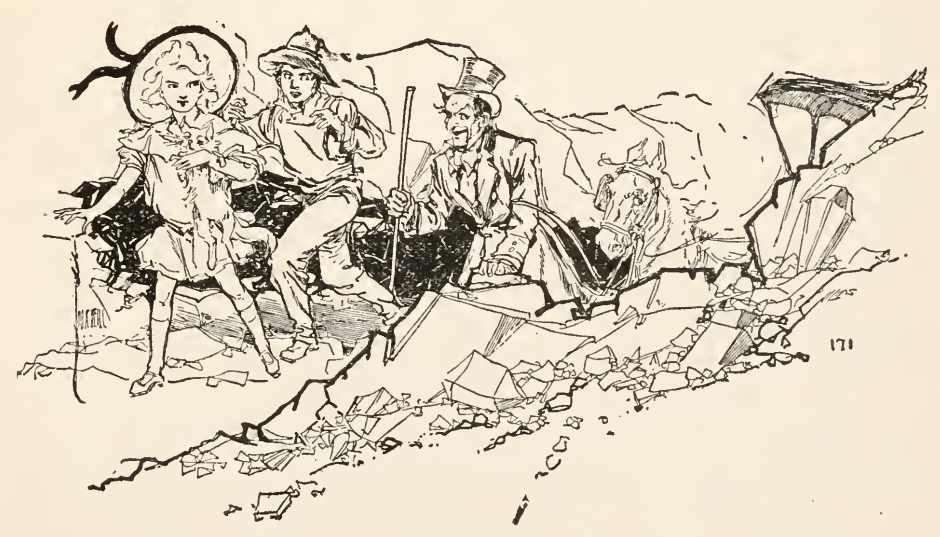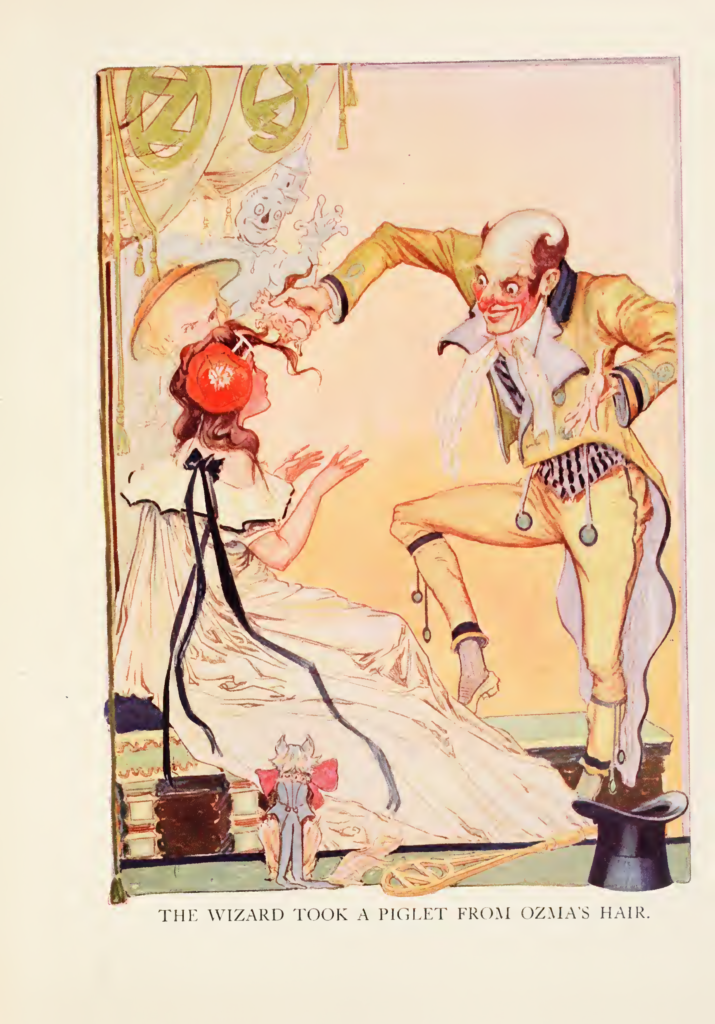
This is because the Wizard is not evil. Though vicious, a trickster, a former conqueror who ruled under false pretenses, and entirely open about being a “humbug” (fraud), throughout the novel, the Wizard shows Dorothy, Zeb, and Jim nothing but kindness. His violence is all to protect them. Eureka gets less kindness from him because one of her major character traits is wanting to eat his pet piglets. But even after Eureka appears to have devoured one of the piglets, the Wizard is remarkably compassionate: “He had no doubt Eureka had eaten his piglet, but he realized that a kitten cannot be depended upon at all times to act properly, since its nature is to destroy small animals and even birds for food, and the tame cat that we keep in our houses today is descended from the wild cat of the jungle—a very ferocious creature, indeed. The Wizard knew that if Dorothy’s pet was found guilty and condemned to death the little girl would be made very unhappy; so, although he grieved over the piglet’s sad fate as much as any of them, he resolved to save Eureka’s life” (237–238). He proceeds to concoct a scheme with the Tin Woodman to undermine the trial, which is already a farce because the people of Oz are not used to having any crimes or trials in the first place. Also because the Woggle-Bug is the prosecutor. The ethical sense of even this situation is ambiguous: the Wizard is helping Dorothy but is doing so by deceiving Ozma and defending (whom he takes to be) a murderer.
Ozma interviews the Wizard in an intriguing exposition dump. In this scene, Dorothy and the Wizard in Oz elaborates on the Wizard’s story that was presented in The Wonderful Wizard of Oz. His real name is Oscar Zoroaster Phadrig Isaac Norman Henkle Emmannuel Ambroise Diggs, “Diggs being the last name because he [his father] could think of no more to go before it” (192). I am aware “Emmanuel” is the typical spelling, but I am accurately representing the Wizard’s name. His name is abbreviated as OZ PINHEAD, and to avoid the embarrassment of being called “pinhead,” he goes by Oz. The Wizard is the son of a politician, perhaps presaging his political future (some people do consider him a representative of the US president in the original novel). While young, the Wizard ran away from home and joined the circus as a ventriloquist, drawing crowds by flying a hot air balloon.
Eventually, the Wizard lost control of his balloon and, after a day and a night, it blew to the Land of Oz, which by sheer coincidence had the same name as him. The locals assumed he was a Wizard because he descended from the clouds, flying machines being unknown in Oz, and the Wizard had them build the Emerald City, using his circus tricks to perpetuate the illusion he was powerful to avoid being attacked by the Wicked Witch of the West and the Wicked Witch of the East. He reigned for many years, until he was an old man, and Dorothy and her friends exposed his fraud. This is as far as the versions of his backstory furnished in The Wonderful Wizard of Oz and Dorothy and the Wizard in Oz do not contradict each other.
After The Wonderful Wizard of Oz, the Wizard’s balloon blows him over the Deadly Desert, leaving Dorothy stuck in Oz on her own, and eventually he returns to Omaha. Like Urashima Tarō, the Wizard discovers the world has moved on without him and that his friends are “dead or had moved away” (194). After this, he returns to the carnie life at Bailum & Barney’s until his balloon descends into the open fissure and he reunites with Dorothy. Since there is nothing left for the Wizard in the mundane world, Ozma decides to let him live in the royal palace as the “Official Wizard” of Oz. Dorothy objects, with friendly teasing, “He’s only a humbug Wizard, though,” to which Ozma replies, “And that is the safest kind of a Wizard to have” (196). He is no longer a threat to the order of Oz and, despite his violence earlier in the novel, can safely be incorporated into the royal retinue as a kind of jester.

Given that the Wizard conspired with Mombi to ruin Ozma’s life and, by implication, might have killed her father, it is strange that Ozma does not bear him any grudge (though she does subtly trick the Wizard, pretending to know less than she lets on). Weirdly, none of the people of the Emerald City seem to bear the Wizard any grudge. Of course, the Scarecrow, Tin Woodman, and Cowardly Lion think well of him, still believing they got their brains, heart, and courage from the Wizard, when really they had them all along. Jellia Jamb tells him, “I’m afraid you cannot rule the Emerald City, as you used to, because we now have a beautiful Princess whom everyone loves so dearly” (187). The Wizard responds, “I assure you, my good people, that I do not wish to rule the Emerald City” (188), at which point everyone welcomes the humbug wizard. Assuming the Wizard can be trusted, he became the ruler of Oz out of self-preservation and fear, believing it was the only way to save himself from the Wicked Witches. Now that Oz is peaceful, the Wizard can spend the remainder of his days in fairyland living his passion: doing parlor tricks to amuse people.
The real reason for this strangeness is that Baum cared little for consistency. You want lore? Get outta here, says Baum, I’m in a rush. He even forgets that a “Gump” is some elk-like animal in The Marvelous Land of Oz, instead saying the weird living flying machine from that novel is the Gump rather than the Thing and that the head, which is supposed to be the Gump, is nameless. But I will take the contradictory material at face value and see what happens.